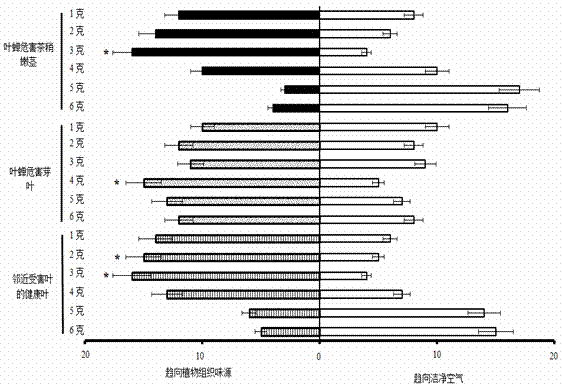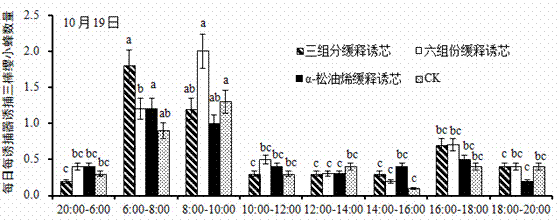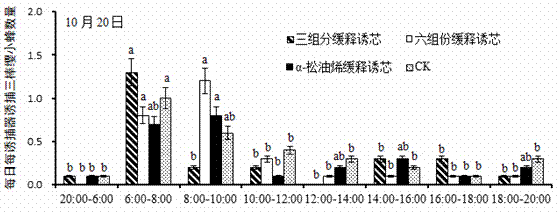Making method for Stethynium empoascae Subba Rao attractant
A technology of tassels wasps and attractant, which can be applied in the directions of attracting pests, botanical equipment and methods, biocides, etc., and can solve problems such as insufficient control of leafhoppers and the like
- Summary
- Abstract
- Description
- Claims
- Application Information
AI Technical Summary
Problems solved by technology
Method used
Image
Examples
Embodiment 1
[0014] Example 1 Attracting effect of three kinds of tea tree tissue odors on leafhoppers
[0015] In the tea tree pot plantation field of China Jiliang University, select more than 10 five-year-old tea trees, connect them with false eye green leafhoppers, and cover them with 60-mesh gauze to prevent the leafhoppers from escaping. After the leafhoppers are damaged for 10 hours: And the tender stems punctured by the oviduct; cut off the buds and leaves that the leafhoppers suck; cut the healthy tea leaves adjacent to the buds and leaves of the leafhoppers. Using the leafhopper three-barreled bee as the test insect, the behavior of the Y-shaped olfactory was measured. The taste source quality of these three plant tissues were 1g, 2g, 3g, 4g, 5g and 6g respectively, and clean air was used as CK in the indoor behavior measurement.
[0016] Compared with the air control, the healthy tea scents of the green leafhopper's mouth needle and oviposition tube stabbed the tea shoots and the gr...
Embodiment 2
[0017] Example 2 The effect of 27 volatiles derived from the odor of three tea tree tissues in attracting leafhoppers
[0018] Using Super Q as the adsorbent, the conventional dynamic adsorption method was used to adsorb the healthy tea scents of "Example 1" on the punctured tender stems, the leafhoppers' mouths that suck the buds and leaves, and the scents of the neighboring healthy tea leaves were GC- MS and other instruments determine the volatile compounds in it, select 27 main components, and prepare 10 -2 g / mL, 10 -4 g / mL and 10 -6 g / mL solution, refer to the method of "Example 1" to determine the behavior of leafhopper three-legged bee, χ 2 The method was used to test the significance of the difference between the number of tasseled bees that selected flavor sources and the number of tasseled bees that selected clean air. The results are shown in Table 1.
[0019] Table 1 The attracting effect of the three doses of 29 kinds of tea tip volatiles measured by Y tube on the leafh...
Embodiment 3
[0025] Example 3 Comparison of the effects of the attractant of the present invention and the other three attractants
[0026] According to the results of "Example 2", the six-component attractant of the present invention is formulated as shown in Table 2, and it is composed of the other three attractants.
[0027] Table 2 Differences in composition between the attractant of the present invention and the other three attractants
[0028]
[0029] There are significant differences. Take 100μl of each attractant, load it on the wool felt, add 1mg of antioxidant 2,6-di-tert-butyl-4-methylphenol, and seal the wool felt with polyvinyl chloride plastic to make the lure core. A pollution-free tea plantation was selected in Yejiawan, Xuancheng City, Anhui Province. From 9-11 am on September 30, 2013, six-component lures, three-component lures, α-terpinene lures and n-hexane lures were selected. Core, and frangipani yellow board. A lure core is attached to a frangipani yellow plate with a s...
PUM
 Login to View More
Login to View More Abstract
Description
Claims
Application Information
 Login to View More
Login to View More - R&D
- Intellectual Property
- Life Sciences
- Materials
- Tech Scout
- Unparalleled Data Quality
- Higher Quality Content
- 60% Fewer Hallucinations
Browse by: Latest US Patents, China's latest patents, Technical Efficacy Thesaurus, Application Domain, Technology Topic, Popular Technical Reports.
© 2025 PatSnap. All rights reserved.Legal|Privacy policy|Modern Slavery Act Transparency Statement|Sitemap|About US| Contact US: help@patsnap.com



